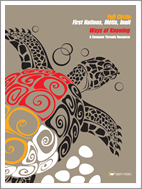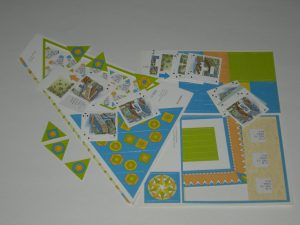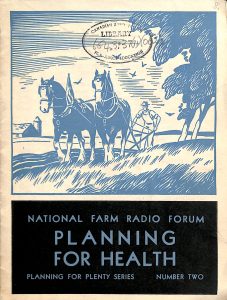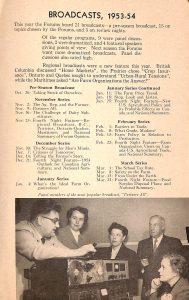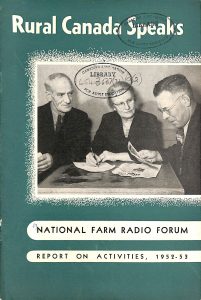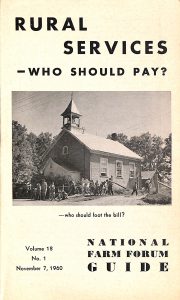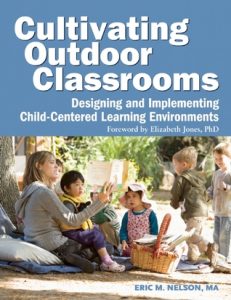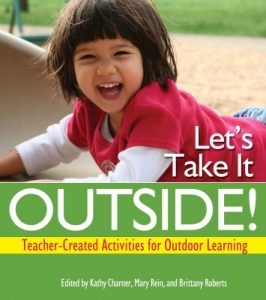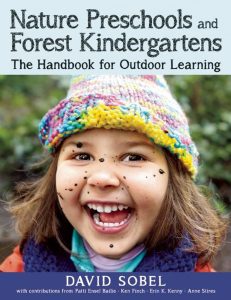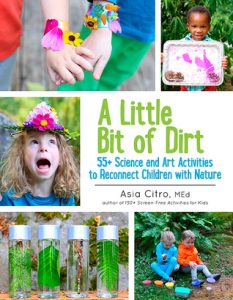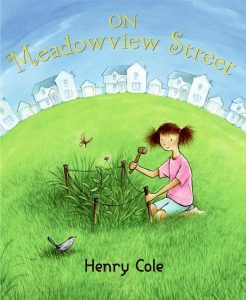For many across the globe, the month of June is recognized as a time of celebration for the LGBTQ+ community. Although it is not yet celebrated everywhere and by everyone, it is incredibly important that such a celebration be recognized as it works to unite and empower the voices of people with diverse sexual orientations, gender identities and gender expressions. Marking the start of a 30-day celebration of a community who has fought and continues to fight for tolerance, recognition and acceptance, Pride is a distinctly special and significant holiday as it represents an entire month in which all forms of self-identity and love are celebrated. The books featured in this post attempt to celebrate the many different voices of those who make up the LGBTQ+ community and to bring awareness to the many ways that sexual and gender diversity can and should be recognized and celebrated in the classroom.
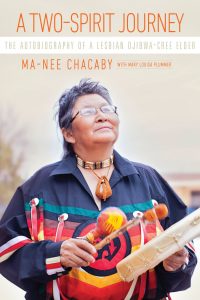 A Two-Spirit Journey: The Autobiography of a Lesbian Ojibwa-Cree Elder is the autobiographical account of the life of Ma-Nee Chacaby, an Indigenous two-spirited lesbian. In this item, Chacaby shares with the reader her lived experiences, detailing the spiritual and cultural lessons she learned from her grandparents, the physical, domestic, and sexual abuse she suffered throughout her life, and her experiences coming out as a two-spirited Ojibwa lesbian. Undercutting this all is her journey in overcoming the legacies of colonialism that have many repercussions, and she speaks to the ways they have affected her social, economic, physical and mental health. Although she experienced severe backlash when she came out in the 1980s, Chacaby became an advocate within the LGBTQ+ community and went on to lead the first Pride Parade in Thunder Bay, Ontario. Chacaby’s story is one of resistance and empowerment, and a great source of inspiration to the LGBTQ+ community. This electronic resource can be virtually checked out through the UofT catalogue.
A Two-Spirit Journey: The Autobiography of a Lesbian Ojibwa-Cree Elder is the autobiographical account of the life of Ma-Nee Chacaby, an Indigenous two-spirited lesbian. In this item, Chacaby shares with the reader her lived experiences, detailing the spiritual and cultural lessons she learned from her grandparents, the physical, domestic, and sexual abuse she suffered throughout her life, and her experiences coming out as a two-spirited Ojibwa lesbian. Undercutting this all is her journey in overcoming the legacies of colonialism that have many repercussions, and she speaks to the ways they have affected her social, economic, physical and mental health. Although she experienced severe backlash when she came out in the 1980s, Chacaby became an advocate within the LGBTQ+ community and went on to lead the first Pride Parade in Thunder Bay, Ontario. Chacaby’s story is one of resistance and empowerment, and a great source of inspiration to the LGBTQ+ community. This electronic resource can be virtually checked out through the UofT catalogue.
Based on the true events that occurred in New York’s Central Park Zoo, And Tango 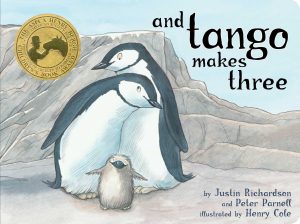 Makes Three is the loving tale of Roy and Silo, two male penguins who found their life-mate in one another. After it became apparent to the zookeepers that Roy and Silo loved each other and had mated for life—as penguins do—they gave the penguins an egg that needed to be cared for so that they could have a family of their own. This item follows the life of these three penguins and features the many acts of love that surround their family. A touching tale of love, family and acceptance, this children’s book is an excellent manifestation of the notion that love and family comes in many forms.
Makes Three is the loving tale of Roy and Silo, two male penguins who found their life-mate in one another. After it became apparent to the zookeepers that Roy and Silo loved each other and had mated for life—as penguins do—they gave the penguins an egg that needed to be cared for so that they could have a family of their own. This item follows the life of these three penguins and features the many acts of love that surround their family. A touching tale of love, family and acceptance, this children’s book is an excellent manifestation of the notion that love and family comes in many forms.
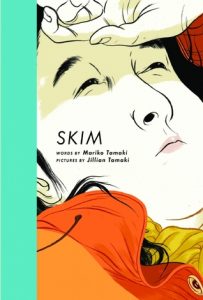 Set in a Toronto Catholic high school, the graphic novel Skim is a beautiful coming-of-age story about a young queer teen named Kimberly, who instead goes by “Skim”. This story follows Skim and her personal struggle with depression, and with discovering and coming to terms with her own sexual orientation. The story begins with the tragedy involving a student in Skim’s school, which leads the school’s administration to redouble their efforts in making students aware of matters concerning mental health. Overwhelmed with the feelings that these events trigger within her, first concerning her personal struggles with her mental health and then with her experience falling in love with a woman, we follow Skim in her journey of self-discovery and acceptance. Skim is an excellent novel that bravely tackles issues concerning mental health and sexuality in a way that is both hard-hitting and profound.
Set in a Toronto Catholic high school, the graphic novel Skim is a beautiful coming-of-age story about a young queer teen named Kimberly, who instead goes by “Skim”. This story follows Skim and her personal struggle with depression, and with discovering and coming to terms with her own sexual orientation. The story begins with the tragedy involving a student in Skim’s school, which leads the school’s administration to redouble their efforts in making students aware of matters concerning mental health. Overwhelmed with the feelings that these events trigger within her, first concerning her personal struggles with her mental health and then with her experience falling in love with a woman, we follow Skim in her journey of self-discovery and acceptance. Skim is an excellent novel that bravely tackles issues concerning mental health and sexuality in a way that is both hard-hitting and profound.
Winner of both the 2018 Outstanding Book by the Michigan Council Teachers of English 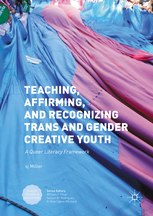 and the 2017 AERA Division K (Teaching and Teacher Education) Exemplary Research Award, Teaching, Affirming, and Recognizing Trans* and Gender Creative Youth: A Queer Literacy Framework is an excellent book that works to create a classroom environment that is safe and welcoming for students of all genders and sexual orientations. This book looks to correct the contemporary absence within classrooms and other educational environments of queer theoretical frameworks that work to implement practical strategies that would recognize, include and respect students of the LGBTQ+ community, and especially those students who are gender nonconforming. With chapters concerning topics such as binary language, gender normatives and Queer pedagogy, this item acts as a great tool which educational administrators can use to ensure they are affirming the experiences of differential (a)gender bodied realities. By highlighting the ways that the current operating social framework within schools has perpetuated or even caused violent climates for students of the LGBTQ+ community, Teaching, Affirming, and Recognizing Trans* and Gender Creative Youth works to dismantle gender normativity in the classroom.
and the 2017 AERA Division K (Teaching and Teacher Education) Exemplary Research Award, Teaching, Affirming, and Recognizing Trans* and Gender Creative Youth: A Queer Literacy Framework is an excellent book that works to create a classroom environment that is safe and welcoming for students of all genders and sexual orientations. This book looks to correct the contemporary absence within classrooms and other educational environments of queer theoretical frameworks that work to implement practical strategies that would recognize, include and respect students of the LGBTQ+ community, and especially those students who are gender nonconforming. With chapters concerning topics such as binary language, gender normatives and Queer pedagogy, this item acts as a great tool which educational administrators can use to ensure they are affirming the experiences of differential (a)gender bodied realities. By highlighting the ways that the current operating social framework within schools has perpetuated or even caused violent climates for students of the LGBTQ+ community, Teaching, Affirming, and Recognizing Trans* and Gender Creative Youth works to dismantle gender normativity in the classroom.
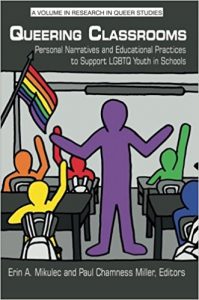 Also addressing the absence of materials surrounding the LGBTQ+ student experience in the classroom, Queering Classrooms: Personal Narratives and Educational Practices to Support LGBTQ Youth in Schools works to directly address the needs of students who do not conform to the gender normative or heterosexual standards of contemporary society. First tackling the problematic nature of an educational theoretical framework that only briefly and off-handedly mentions the needs of the LGBTQ+ student community, this item advocates for the need of both a teacher education and curriculum that directly and openly addresses LGBTQ+ topics and issues, as well as the needs of LGBTQ+ learners. By highlighting the many different ways that LGBTQ+ students may experience discrimination or oppression within schools specifically, Queering Classrooms is an insightful text that works to eradicate any educational ignorance surrounding the LGBTQ+ community so to ensure its educational and social empowerment.
Also addressing the absence of materials surrounding the LGBTQ+ student experience in the classroom, Queering Classrooms: Personal Narratives and Educational Practices to Support LGBTQ Youth in Schools works to directly address the needs of students who do not conform to the gender normative or heterosexual standards of contemporary society. First tackling the problematic nature of an educational theoretical framework that only briefly and off-handedly mentions the needs of the LGBTQ+ student community, this item advocates for the need of both a teacher education and curriculum that directly and openly addresses LGBTQ+ topics and issues, as well as the needs of LGBTQ+ learners. By highlighting the many different ways that LGBTQ+ students may experience discrimination or oppression within schools specifically, Queering Classrooms is an insightful text that works to eradicate any educational ignorance surrounding the LGBTQ+ community so to ensure its educational and social empowerment.
For these and more books on LGBTQ+ topics, visit the Lobby Display on the ground floor of the OISE building. Please feel free to take out the materials found in the lobby display—OISE staff would be happy to take these out for you. Happy Pride everyone!!!

